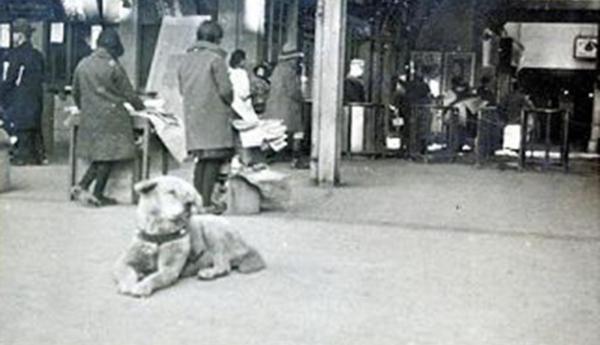The True Story of Hachiko - The Faithful Dog



See files for Dogs
Hachiko was a dog known for his infinite fidelity and love for his owner, Eizaburo Ueno. This dog is known as the faithful and lonely dog as he waited for his owner at the train station after he returned from work, even after his owner's sudden death.
In this AnimalWised article we're going to tell the tale of this amazing dog, this is the true story of Hachiko, the faithful dog.
Who was Hachiko the faithful dog?
Hachiko was a dog known for his infinite fidelity and love for his owner, Eizaburo Ueno, a university professor in Tokyo, Japan. Every afternoon, Hachiko (stylized as Hachikō in Japanese) waited at the Shibuya train station until his owner returned from work - even after his tragic sudden death.
This display of affection and loyalty has made Hachiko's story become world famous. It has even made it onto the big screen with a movie.
This is the perfect example of how the love of a dog can be as strong as the love of humans. So let's get into the true story of Hachiko “the faithful dog”, grab some tissues and keep reading this AnimalWised article!
Life with the professor
Hachiko was an Akita Inu who was born in 1923 in Akita prefecture, Japan. A year later he became a gift for the daughter of a professor of agronomic engineering at Tokyo University. When the professor, Eisaburo Ueno, saw him for the first time, he realized that his legs were slightly crooked. They resembled the kanji that represents the number 8 (八, which in Japanese is pronounced hachi), so he decided to name him Hachiko (ハチ公).
When Ueno's daughter grew up, she married and went to live with her husband, leaving the dog behind. The teacher had grown very fond of him, so he decided to keep Hachi instead of giving him away.
Ueno went to work by train every day and Hachiko became his faithful companion. Every morning he accompanied him to the Shibuya train station and in the afternoon he went back to meet him when he returned. This example of true loyalty is what inspired the people of Tokyo at the time and the rest of the world since.

The death of his master
One day, while teaching at the university, Ueno suffered a sudden cerebral hemorrhage which ended his life. However, Hachiko continued to wait for him at the Shibuya station.
Day after day Hachiko went to the station and waited for hours for his owner, looking for his face among the thousands of strangers passing by. These days turned into months and months and eventually into years. Hachiko waited tirelessly for his owner for nine long years. Through rain, snow or sunshine. He would appear at the exact time his master's train awas due in the station.
The inhabitants of Shibuya knew Hachiko and has regular seen him with professor Ueno. Due to the busyness of the station, many found it annoying to have the dog getting in the way. However, when they realized what had happened, they took charge of feeding and taking care of him while he waited in the door of the station. They soon realized the reason he was there was supreme loyalty. This loyalty for his owner earned him the nickname “the faithful dog”.
People have shown much affection and admiration for Hachiko and his loyalty. So much so, a statue of him was revealed in 1934 in front of the same train station where he waited for his owner every day.

Death of Hachiko
On March 9, 1935, Hachiko was found dead at the foot of the statue. He was 11 and it appears he died because of old age. It adds poetic resonance to the Hachiko story that he died in the same place where he had waited for his owner's return for nine years. The remains of the faithful dog were buried next to those of his owner in the cemetery of Aoyama in Tokyo.
During World War II all Japanese statues made from bronze were recast to manufacture armaments, including that of Hachiko. Nevertheless, a few years later, a society was created to produce a new dog statue and to put it in the same place. Takeshi Ando, the son of the original sculptor, was hired to rework the statue. This goes to show that the story of Hachiko had endured long after his death. Perhaps such inspiring stories were even more necessary after a war.
Today the statue of Hachiko continues to stand in the same place, in front of the station of Shibuya. Every April 8th a special day is celebrated which commemorates his fidelity.
After all these years the story of Hachiko, the faithful dog is still alive because his love, loyalty and unconditional affection shook the heart of a population. And still continues to do so today. His legacy lives on.

The story of Hachiko and its legacy
The story of the dog Hachi has continued in the hearts of those who heard it. This legacy is one which is kept alive thanks to the story's retelling. Many people in Japan have told this story to from older generations to younger. However, it is also important to remember that the faithful dog's story was not only popular posthumously.
Hirokichi Saito was one of professor Ueno's students and he grew a strong interest in the Japanese Akita dog breed. He even developed Nippo (Nipponinu Hozonkai - Japanese Dog Preservation Society) and is more than partly responsible for this dog's regained popularity. In fact, through his research, we learned that Hachiko was only one of around 30 purebred Akita Inu dogs still alive.
Saito's love for Akitas and Hachiko in particular led to him writing various articles which helped to publicize his story. These stories spread so wide that in 1987 the first movie about Hachiko was released. The Japanese language Hachikō Monogatari (‘The Tale of Hachiko’) was the number one movie in Japan at the time of its release. Hachiko's story received the Hollywood treatment in 2009 with the release of Hachi: A Dog's Tale staring Richard Gere as an anglicized version of the real life professor Ueno.
The legacy of Hachiko's story can be seen in diverse ways from children's books to plot lines in episodes of Scooby Doo. One of the most appropriate is the naming of a new minibus in the Shibuya ward ‘Hachiko-bus’.

If you want to read similar articles to The True Story of Hachiko - The Faithful Dog, we recommend you visit our Facts about the animal kingdom category.






 May God bless him
May God bless him




